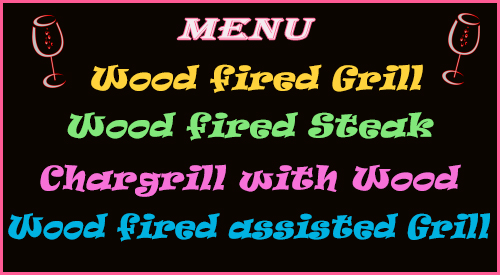Wed 19 Apr 2017
WOOD-FIRED GRILL RESTAURANT MENU- WHEN A FLOP COULD HAVE BEEN A SUCCESS!
Posted by DrSmokeRead other related stories: Commercial , Cooking , Smoking Tips
No Comments

Menu board found in most restaurants- highlighting wood-fired grill
WHEN A FLOP COULD HAVE BEEN A SUCCESS WITH THE WOOD-FIRED GRILL!

There is no question that being in the franchise restaurant business is a challenge especially given that there is a national menu dictated by the brand you partnered with. I am amazed at the risks brands will take when it comes to making a major capital investment in marketing strategies, equipment upgrades, and personnel training for single concepts. Case in point: the obsession with wood-fired grilling to get customers in or coming back!
Here are just a few brands that took the leap of faith into the wood-fired grill market:
- Carrabba’s Italian Grill
- Applebee’s Grill & Bar
- Outback Steakhouse
- Red Lobster
- Logan’s Roadhouse
- Bonefish Grill
Certainly, not all these efforts have resulted in 100% failure as often the addition of a wood-fired oven or grill was added for other menus items that had an established following or existed from the conception of the franchise. For instance, Carrabba’s Italian Grill offers wood-fired pizza in their brick oven so it is not a giant leap for them to do wood-fired chicken. The same can be said for Bonefish Grill whose focus is fresh fish. Logan’s Roadhouse and Outback Steakhouse bring diners in for mostly steak and that is a protein accustomed to being cooked by fire.
What happens when a decision is made by a brand to go into this unchartered area?
There are two franchises that standout on this topic: Red Lobster and Applebee’s Grill & Bar. More than 6 years ago, Red Lobster began a major marketing campaign on their newly launched “wood-fired assisted grills”. The brand stated a commitment to using oak wood for their wood-fired menu items. At some locations, though not all, you would find a log holder with firewood logs outside or just inside the front door. In 2016, Applebee’s Grill & Bar attempted a major menu change with the introduction of wood-fired steaks, pork, chicken, and salmon which required the purchase and installation of wood-fired grills to its nearly 2000 locations. Why don’t you see these two brands focused on wood-fired menus any longer? The short answer is, they didn’t study the market on wood-fired cooking with the help of a wood expert!
What should have been done to make this capital venture, this leap-of-faith, successful? By far, the most pivotal mistake made was not understanding the role the wood plays in food flavor. Both Red Lobster and Applebee’s Grill & Bar defaulted to using oak, an extremely strong wood to use in cooking. Also, they elected to use firewood meaning that the variety of oak, if not sourced by one supplier, would vary by region or state, if indeed they received oak exclusively. Most firewood suppliers do not sell one type of wood. In fact, firewood could be a mix of softwood and hardwood which should be of great concern when you are targeting cooking.
Understand, that most franchise brands do not come up with a concept and immediately put it in place. There is a testing period, usually two, whereby they take a small sampling of their locations and put the new menu items in place. Then they collect feedback and data. The catastrophic failure that occurred for Applebee’s Grill & Bar is that they did not stay true to the procedures set in place during the testing period when they rolled this out to nearly 2000 locations. The result: they will turn in the worse 2016 sales numbers for a franchise restaurant.
What is the lesson to take away?
If you are considering adding wood-fired menu items to your business, do your research! Don’t get enamored with the idea of this style of cooking. Learn from an expert what occurs to foods exposed to live fire, what changes result flavor-wise, and what to avoid in wood choices based on the equipment. Most of all, start out by understanding, not all wood is appropriate for cooking and not all suppliers have great wood. Then take advice from the expert rather than risking not only the success of your business but the health and experience of your guests who dine with you.

Dr. Smoke- Learn about the wood-fired grill issues with restaurants